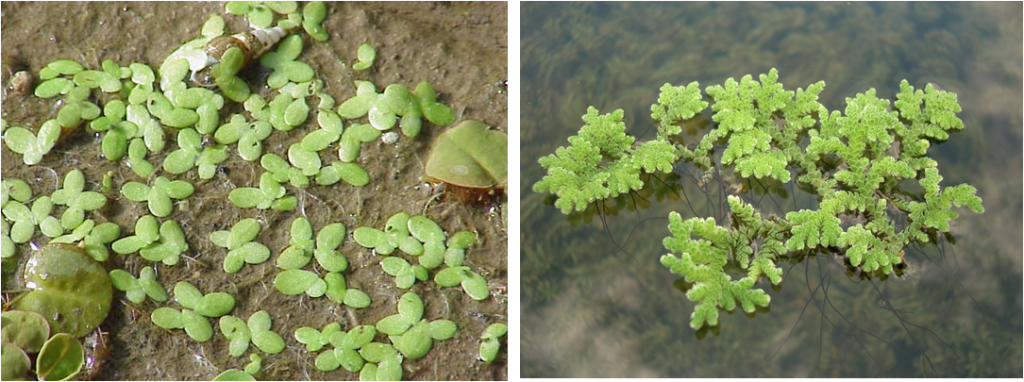The genus Azolla was established by the French naturalist Jean-Bapitiste Lamarck in 1783 based on the specimens collected by Philibert Commerson and his assistant Jeanne Baré from the Magellan region of South America during Louis-Antoine de Bourgainville’s1766-1769 expedition around the world:
“It is a small aquatic plant which appears to float on the water surface in the manner of Lenticules (Lemna) with whom it seems to have a great relation and which nevertheless looks like a small fern.” (translation from the French)
Lamarck’s observation of azolla’s habitat must have been based on Commerson’s own observations because at this time azolla was not native to Europe.
Lamarck did not refer to the origin of the name that he gave azolla, only saying that:
“Cette plane a ete rappertee de Magellan par M. dr Commerson”. (This plant was brought from Magellan by Mr. Commerson).
Traditionally, the name is referred to a conjugation of two Greek words, azo (to dry) and allyo (to kill), because the fern is killed by drought, but Carrapiço (2010) has suggested that the name was adopted from a word used by the local population in Argentina or Chile where Commerson collected his specimens of azolla.
Perhaps both versions are true. Maybe Lamarck was aware of the local usage and then constructed a name that sounded similar using a Greek nomenclatural base.
Azolla’s many names
Azolla also has numerous names in different countries and languages, including the following, with the local names shown in red:
Carolina fern, Duck fern, Duckweed fern, Fairy fern, Fairy moss, Feathered water fern, Mosquito fern*, Pacific mosquito fern, Red water fern, Water velvet (English, including North America and Australasia)
*Mosquito fern derives from azolla’s ability to suppress the propagation of mosquitoes on freshwater bodies.
Watervaring (Afrikaans)
অ্যাজোলা (Bengali)
满江红 (‘Azolla‘), Lu P’ing, Ho P’ing, Man Chiang hung shu (Chinese)
Andematbregne (Danish and Norwegian)
Grote kroosvaren (Dutch)
Limaskasaniainen (Finnish)
Algenfran (‘azolla’), Grosser Algenfarn (Azolla filiculoides), Kleiner Algenfarn (Azolla caroliniana) (German)
アカウキクサ属, Akaukikusa, Koakaukikusa, Ooakaukikusa (Japanese)
Chak pos kra hey, Chak krahan (Khmer)
Nae harnghern (Lao)
šakotoji azolė (Lithuanian)
അസോള (Karali, Malayam)
अजोला (Marathi)
زیریان (‘Zryan’) (Persian)
Азолла (Russian)
Helecho de agua, Heleechito del agua, Helecho de pato (Spanish)
Mossbräken (Swiss – German-speaking Canton)
அசோலா (Tamil)
แหนแดง (Thai)
Beo hoa dau, Beo giau (Vietnamese)
Cyfrdwy (Welsh)
אַזאָללאַ (Yiddish)
Comparison of azolla and duckweed
Azolla is sometimes called ‘small duckweed’, but this is a misleading name. Azolla is a pteridophyte, whereas duckweed (also known as ‘water lens’ or ‘bayroot’) is an aquatic angiosperm (flowering plant) of the Family Lemnoideae which has five genera: Spirodela, Landoltia, Lemna, Wolffiella and Wolffia.
Unlike azolla, duckweed does not contain endosymbiotic cyanobacteria.
Azolla and duckweed are often found growing together in freshwater ponds, lakes and other bodies of still or sluggish water.
Definition of the genus Azolla
The genus Azolla is defined as a heterosporous leptosporangiate fern from aquatic and semi-aquatic habitats. It is assigned to the monogeneric Family Azollaceae.
Subdivision of the genus
The genus Azolla’s speciation has varied according to various authors’ interpretations and it is presently undergoing revision. According to Francisco Carrapiço (personal communication to J. Bujak), the genus Azolla has six species and three subspecies:
“The problem related to the modern Azolla species is still an open question, but based on the classification proposed by Saunders & Fowler (1993) we can consider the following species and subspecies:
Species:
Azolla caroliniana
Azolla filiculoides
Azolla mexicana
Azolla microphylla
Azolla pinnata
Azolla rubra
Subspecies:
Azolla pinnata subsp. africana
Azolla pinnata subsp. asiatica
Azolla pinnata subsp. pinnata
The genus Azolla also has several fossil species which date back approximately 70 million years to the Late Cretaceous. These include Azolla arctica which were deposited 50 million years ago during the Eocene Arctic Azolla Event.
Azolla hybrids
Hybrids are commonly produced and selected because they have desirable characteristics not found or inconsistently present in the parent individuals or populations. Hybridization is the result of interbreeding between two animals or plants of different taxa, including species, genera and, in rare cases, families.
Hybrids between different species of the same genus are known as interspecific hybrids or crosses. Hybrids between different sub-species are known as intra-specific hybrids. Hybrids that result from crosses between populations are known as breeds or cultivars of a single species.
Azolla hybrids have been developed to improve the plant’s temperature tolerance and biomass production. For example, hybridization between A. microphylla and A. filiculoides improves annual biomass production, as illustrated by a study by Van Cat et al. (1989).
In the parent material, the latter grows better in the spring, while the former grows better in the summer and autumn due to its higher-temperature tolerance. The hybrid, however, produced biomass comparable to that of A. filiculoides in the spring and comparable to that of A. microphylla in the summer and autumn, thus boosting overall annual production. Van Cat et al. (1989) showed that the hybrid did not show stress (characterized by a red color) under phosphorus- or calcium-deficient conditions and that the hybrid had a higher nitrogen content than the parent A. microphylla. Biomass production in the field was also higher in the hybrid than that of A. microphylla.
In another study, Kannaiyan & Kumar (2005) screened azolla hybrids AH-Cl, AH-C2, AH-C3 and AH-C4 with wild cultures of A. filiculoides and A. microphylla to produce a better biomass. They found that Azolla hybrids produced a greater biomass than wild cultures of A. filiculoides and A. microphylla. AH-C2 produced the greatest biomass with a shorter doubling time and a higher relative growth rate followed by AH-C1.
IRRI’s azolla germplasm collection
The Philippines’ International Rice Research Institute (IRRI) has the world’s largest germplasm collection of azolla with more than 500 hybrids. The IRRI is a Foundation Associate and has kindly agreed to make it available to the Azolla Foundation for research projects.



